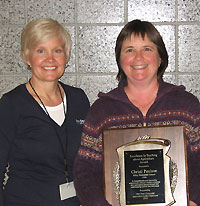Teacher Award
State & National Teacher Award 2010
Christi Paulson

The theme for my first grade classroom this year was cycles in nature and our world. I wanted my students to be able to recognize cycles in the world around them and then draw on this knowledge to help them discover how other things in the world worked. This turned out to be an effective learning strategy. Whenever a student recognized a cycle—whether it was in a story or a science lesson—they would get excited that they could identify the cycle. This gave my students confidence and something with which they could build more knowledge.
We started with lessons about seasons and the power of the circle as it relates to cycles. Each student made a seasons poster. We discussed and completed cycle pictures of the Nutrient Cycle, Oxygen Cycle and Water Cycle. To assist the students with remembering the water cycle, we learned the song and dance, The Water Cycle Boogie, by The Banana Slug String Band.
Most of my students were unaware of the ingredients needed to make bread. Grains of wheat (that were seeds!) were a new concept for them. We threshed and removed the chaff from the wheat seeds and then ground them using a hand-operated wheat grinder. Students were surprised at how difficult it was to grind enough wheat to make something to eat. We made tortillas with the flour we'd ground. These activities were centered on the reading of many versions of The Little Red Hen. We then made a brochure together about the story and the steps necessary to make tortillas. I provided the template for the brochure but the class, as a whole, added the content. A copy of the story brochure was sent home with each student as "homework" to share with their family.
I included lessons and activities on worm composting to help students understand the fertility cycle in the soil. We made a worm bin and discussed composting and what the worms were doing. The students kept the scraps from our fruit and vegetable snacks to feed to the worms. We found that the smaller we chopped the leftover snacks, the faster the worms could eat them. We learned about the parts of the worm through careful observation. We also read Wiggling Worms at Work, and discovered that worms help improve the soil for plants. The plant cycle was started by harvesting seeds from radish plants that another teacher had left in his garden box. We grew these seeds in our box and then ate the results, again reinforcing the students' understanding of systems and agricultural cycles.
One of the most important lessons I used was "Who Makes the Best Burger?" Because students are so familiar with hamburgers, this was a concept to which they could easily relate. The most rewarding part of the lesson was the impact on the children's agricultural literacy as they discovered the true source of their burgers, buns, and all the condiments.
The capstone project for our year was making a plant movie. We had taken many photographs throughout the year while we were working inside with our GrowLabs and outside with our schoolyard gardens. We also learned songs about plants and read several books about plant parts. (We located these plant parts in the gardens to reinforce our book learning.) We wrote the movie script and decided which photos worked best. Each student then practiced their part until they were very proficient at reading it. We recorded each student's narration, and I matched it with the appropriate photo. We sang the songs we'd learned and showed many photos of us throughout the year. This was a very interactive way to reinforce everything we had learned all year. I also wanted the students exposed to the technology so they could see what is possible and how technology can be used. We had a final spring program for our families, the kindergartners, and the second-graders. Our class was very proud of their movie, and I made a copy for each student to take home.
